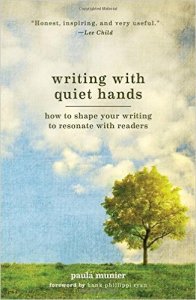Are you pursuing traditional publishing? Do you feel your manuscript is ready to be put in front of an editor or agent? Go through this list before you do! (If self-publishing, further recommendations are at the end of this post.)
According to Literary Agent Paula Munier in her new book: Writing With Quiet Hands, there are three major drafts before you arrive at a publishable novel.

First Draft: Write whatever you wish to write, be it from a carefully constructed outline or by the seat of your pants. Don’t worry about the words, just get them down on paper. You can make it pretty later.

Using your feedback, sit down and do a “big picture” edit. Some hire a developmental editor for this kind of edit, which is NOT the same as a line edit. That’s for the third draft.
A *big picture edit should include:
- You have a likable protagonist.
- The main character leads the plot by their choices and aren’t a passive character where the plot just seems to “happen” to them.
- Plot Arc with a clear beginning, middle, and end. A logical sequence of events that seamlessly lead from one plot point to the next. If you didn’t write an outline for your story, you should write one now to properly analyze your plot flow.
- Sub-Plot arcs are present and add to the story.
- Logical and completed character arcs: The main character is trying to fix a problem and only seems to make it worse, encountering obstacles, good intentions gone wrong hinder your main character along the way until they finally get what they’re after, and have grown as a character at the same time. All antagonists are relatable, and even if we hate them, we can still empathize with their actions.
- Truly understanding your characters will help
ifwhen you do a rewrite. You’ll be able to write with more conviction, and perhaps find a sense of voice you had been missing because you honestly didn’t really know the rooted motivations of why your characters did what they did, and what they wanted out of life.
- Truly understanding your characters will help
- Narrative Thrust: The reader is constantly asking questions that will lead to the next plot point, which is essential to keeping their interest. Paula has a large chapter dedicated to this concept as well as a guest blog post, and I can’t stress its importance enough. (I have no affiliation with Jane Friedman’s blog, I’m just one of her many readers.)
- Every character and scene has a purpose and serves to develop the story.
- There is a healthy balance of Character, Description, Backstory, Setting, and Conflict. (Meaning no info-dumps, and no superfluous information.)
Have you done a REAL Second Draft?
Remember, you’re not answering me, you’re answering yourself. You need to sit down and think long and hard and ask yourself, have I done everything possible to do a proper second draft?
If you are squirming in your chair and going b-b-but… don’t shy away from it! This is a good thing. There’s actually something YOU can do in order to make your book more attractive to agents. Isn’t that awesome? If you saw an advertisement that said “Guaranteed product to make your manuscript more attractive to agents,” wouldn’t you buy it? It isn’t a secret, you will meet your goals if you want it bad enough, and that comes with putting the work into understanding your story down to its core and revising until it’s right.
This doesn’t mean you have to go hire a developmental editor, and I wouldn’t recommend it anyway unless you have reliable writer friends who can give proper recommendations. There are freelance editors out there who don’t really know what they’re doing, and you have to learn how to edit your own work anyway!
Buy some books written by respectable authors/editors/agents, join a writers’ critique group, read recent debut novels that broke into your genre and study what about them you can emulate– in short, commit yourself to the craft. If you want to meet your goals, that’s how it’s going to happen. Believe in yourself and what you’re capable of, you’re stronger than you realize.

You’ve done everything you can to make the nitty-gritty content of your novel the best it can possibly be. You have an awesome, likable main character, you have a villain we love to hate, and you’ve got a premise that is skillfully executed.
Now you need to do a line edit, and this is what really makes your novel shine. How much effort you spend on this draft is the equivalent of how much a jeweler polishes his gems. Don’t hand over your novel with grime and grit caked on it to an agent, not when you know it’s an uncut diamond not ready to be set in a ring. Take your time and weed out all unnecessary words, and achieve a review that labels your prose as “crisp” and “elegant.” Read your novel out loud, and any place you find yourself tripping means you’ve got a sentence you need to either reword, or cut altogether. If it doesn’t work, don’t stress over it. Sometimes it’s easier to delete than to repair.
I think a big mistake novelists make is heading straight into the third draft. When s/he realizes the novel didn’t have a proper second draft, things need to be rewritten, and now s/he has completely wasted their time icing a cake that wasn’t yet baked. Don’t be impatient! Give your novel the second draft it deserves and you’ll find your novel is much better received when it’s time to pitch it to an agent.
While this post is also relevant for self-publishing, there’s a whole lot more than goes on behind the scenes until your book is truly ready for the shelf. For self-publishing, I suggest consulting these free kindle guides:
- Self-Publishing Books 101: A Step-by-Step Guide to Publishing Your Book in Multiple Formats (Author 101 Series)
- Successful Self-Publishing: How to self-publish and market your book in ebook and print
*This is my take of a “big picture edit” based on my study of Writing With Quiet Hands, and is not a copy/paste of the book’s content. That said, this post is a brief summary of the large extent Paula goes into of what a big picture edit really means, and how to do one. I suggest reading her novel if you would like to be inspired to write, pick up tips, and good writing habits from someone who knows.

That’s interesting…I never consider my first draft ready for anyone else’s eyes. I’m much more of a “second or third draft is the time for others to see it” kinda person. I guess I don’t consider my first draft “good enough” for another to read–there’s always so much that didn’t come out right the first time around that I have to fix before I would ask another to slog through it! 🙂
Oh, and thanks for the tips on the free Kindle books! 🙂 I love free books!
LikeLiked by 1 person
I was surprised too when I read Paula’s recommendation to have beta readers after the first draft. But when I thought about it, if a first draft is revised before a beta read you’re getting feedback on garbled information. Maybe you fixed things that didn’t need fixing or added things that didn’t need to be added. It probably saves a lot of time getting feedback on the first natural work you write, and then work on the second draft armed with the proper information instead of trying to go solo. Though in the end it’s whatever works for the author, both routes are going to get the same result in the end.
I like free books too! Happy to help 🙂
LikeLiked by 1 person
That’s true…but I think I depart from this line of thinking just because when I write my first draft, I know that things aren’t the way I want them. I have to be somewhat happy with a book first before sharing it with others, I guess. Although sharing a first draft might take the pressure off that second draft… Eh. The only way I can imagine this working for me is if I have outlined my first draft prior to writing it and it turns out in relatively good shape structurally. Otherwise I feel it would be a waste of time for Beta readers as well as myself… But definitely worth considering….
LikeLiked by 1 person